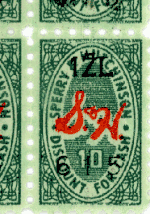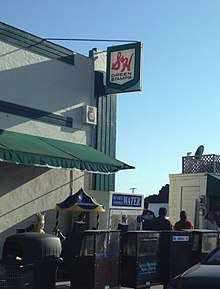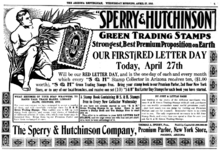S&H Green Stamps
S&H Green Stamps was a line of trading stamps popular in the United States from the 1930s until the late 1980s. They were distributed as part of a rewards program operated by the Sperry & Hutchinson company (S&H), founded in 1896 by Thomas Sperry and Shelley Byron Hutchinson. During the 1960s, the company promoted its rewards catalog as being the largest publication in the United States and boasted that it issued three times as many stamps as the U.S. Postal Service. Customers would receive stamps at the checkout counter of supermarkets, department stores, and gasoline stations among other retailers, which could be redeemed for products in the catalog.[1] Top Value Stamps, acquired by Tom Ficara in 1990 and now a division of TVS Television Network, and S&H are the only two surviving legacy stamp programs.


S&H Green Stamps had several competitors, including Greenbax Stamps offered by Piggly Wiggly, Gold Bell Gift Stamps (in the Midwest), Triple S Stamps (offered by Grand Union Supermarkets), Gold Bond Stamps, Blue Chip Stamps, Plaid Stamps (a project of A&P Supermarkets), Top Value Stamps, Quality Stamps, Gunn Brothers given by Safeway, Buccaneer, and Eagle Stamps (a project of several divisions of the May Department Stores Co. of St. Louis, Missouri and offered, notably, by May Company stores, supermarkets, drug stores, gas stations, and dry cleaners in the Cleveland, Ohio, area).[2][3]
History



Beginnings
Sperry & Hutchinson began offering stamps to U.S. retailers in 1896. The retail organizations that distributed the stamps were primarily supermarkets, gasoline filling stations, and stores. They bought the stamps from S&H and gave them as bonuses to shoppers based on the dollar amount of a purchase. The stamps were issued in denominations of one, ten, and fifty points, perforated with a gummed reverse. As shoppers accumulated the stamps, they moistened the reverse and mounted them in collector's books, which were provided free by S&H. The books contained 24 pages and filling a page required 50 points, so each book contained 1,200 points. Shoppers could then exchange filled books for premiums, including housewares and other items, from the local Green Stamps store or catalog. Each premium was assigned a value expressed by the number of filled stamp books required to obtain it.
Classification
Green Stamps were one of the first retail loyalty programs,[4] by which retailers purchased the stamps from the operating company and then gave them away at a rate determined by the merchant. Some shoppers would choose one merchant over another because they gave out more stamps per dollar spent.[5]
International
The company also traded overseas. During the early 1960s, it initiated S&H Pink Stamps in the United Kingdom, having been beaten to their green shield trademark during 1958 by Richard Tompkins's Green Shield Trading Stamp Company.[6]
Decline
Economic factors
The program had its greatest popularity during the mid-1960s, but a series of recessions during the 1970s decreased sales of green stamps and the stamp programs of their competitors. The value of the rewards declined substantially during the same period, requiring either far more stamps to get a worthwhile item or spending money for an item that was barely discounted from the price at regular stores, creating a general downward spiral as fewer and fewer people saw them as worth the trouble.
Legal issues
In 1972, the company was brought before the United States Supreme Court for violating the unfairness doctrine. In FTC v. Sperry & Hutchinson Trading Stamp Co., the court held that restricting the trade of the stamps was illegal.
Sperry and Hutchinson was sold by the founders' successors in 1981. In 1999, it was purchased from a holding firm by a member of the founding Sperry family. At that time, only about 100 U.S. stores were offering Green Stamps.
On-line factors
Eventually, with the rise of the Internet and the World Wide Web, the company modified its practices, and offered "greenpoints" as rewards for online purchases. The Greenpoints could be earned and redeemed at only a few stores, such as Foodtown in New York state and New Jersey.
Renaissance
Anthony Zolezzi, founder of Pet Promise and Greenopolis Recycling,[7] reportedly purchased the company in 2013 with plans to relaunch it.
Furniture division
Between 1969 and 1971, Sperry & Hutchinson bought four furniture companies, which became part of a Richmond, Virginia-based furniture division in 1974. While S&H bought other furniture companies, the first four became a High Point, North Carolina-based division called S&H Furniture in 1976. In 1981, S&H executives bought the division along with other investors, forming LADD Holding Co. in 1981 and LADD Furniture Inc. in 1983.[8]
S & H Solutions
The company operated S&H Solutions, a sales training and incentives program developed for its own sales force but run as a separate profit center offering services to other employers.
On December 7, 2006, it was announced that S&H Solutions was purchased by San Francisco-based Pay By Touch. The purchase price was in excess of $100 million in cash and stock. Pay By Touch suddenly shut its operations in 2008 and sold its assets to other corporations.
References
- Hatala, Greg (November 4, 2013). "Made in Jersey: S&H Green Stamps - in the sixties, Americans were stuck on them". NJ.com. Retrieved 2015-12-27.
- Morrell, Alan (July 31, 2015). "Whatever Happened To ... trading stamps?". Rochester Democrat and Chronicle. Retrieved 2015-12-27.
- Cellania, Miss (March 17, 2015). "Free with Purchase: The Age of Trading Stamps". Neatorama. Retrieved 2015-12-27.
- Lach, Jennifer (May 1, 2000). "Redeeming Qualities". Advertising Age. Retrieved 2014-03-08.
- Burke, Melissa Nann (November 4, 2010). "Remember: S&H Green Stamps". The York Daily Record. Retrieved 2014-03-08.
- Richard Davenport-Hines (2004). "Tompkins, (Granville) Richard Francis (1918–1992)". Oxford Dictionary of National Biography, Oxford University Press. Retrieved 2008-06-19.
- "Executive Profile: Anthony J. Zolezzi". Bloomberg.com. 2017.
- See International Directory of Company Histories, Vol. 12. St. James Press, 1996
External links
| Wikimedia Commons has media related to S&H Green Stamps program. |